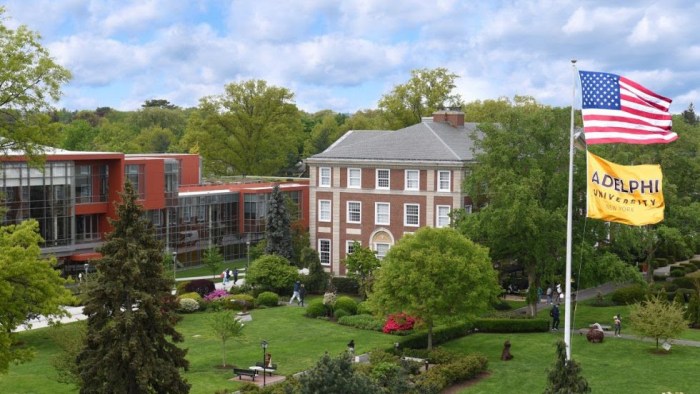Hundreds Attend Rally, Environmental Hearing
The Aug. 4 environmental hearing on the Lighthouse proposal played out more like a pep rally for project developers Scott Rechler and New York Islanders owner Charles Wang, who received rousing applause before he spoke to a packed crowd at the John Cranford Adams Playhouse on Hofstra’s Hempstead campus.
The Lighthouse Development Group partners hope to transform the Nassau Veterans Memorial Coliseum and its surrounding 150 acres into a “signature destination” on Long Island, complete with 2,300 residences, 500,000 square feet of retail, a 5-star, 300-room hotel – a first for Long Island, an ice rink and more.
“The Lighthouse is hope for Long Island and we are closer than we’ve ever been before,” Wang, founder and principal of the Lighthouse Development Group, said. “The Lighthouse Project is something which has mobilized Long Islanders to get behind a future for their families and future generations … The Lighthouse is a catalyst to kick-start Long Island’s economy, and we need it now.”
The hearing, Hempstead Town Supervisor Kate Murray said, afforded government agencies, elected officials and the general public a chance to weigh in on the Lighthouse Development Group’s state-mandated environmental report (Draft Generic Environmental Impact Statement), which included traffic, air quality, sewage, drinking water, garbage disposal and more.
“The Hempstead Town Board is intently focused on innovative development at and around the Coliseum. Jobs, economic stimulation and tax revenues are important benefits of major construction projects like this,” Supervisor Murray said. “The town board also must make sure that state-mandated and other project reviews are done properly, because the decisions we make today will affect our children and our grandchildren.”
Many, including former NY Islanders Bob Nystrom and Mike Bossy and National Hockey League Commissioner Gary Bettman, never touched upon environmental issues but instead praised the project and urged Town of Hempstead officials to expedite the approval process to get shovels in the ground as soon as possible.
“Long Island needs to continue growing and the Lighthouse project is exactly what we need,” Nystrom, who was drafted by the Islanders in 1972, said.
While many dub the project “Long Island’s own stimulus package,” others remain cautious, fearing that such a massive amount of retail space could hurt already struggling merchants in surrounding downtowns.
Roger Eltringham, president of the Garden City Chamber of Commerce, has a “queasy apprehension” about the future.

“As things stand today, we can’t even support the retail space that already exists. Glen Cove Road, Old Country Road, The Source, the former Avis property and even Roosevelt Field have gaping vacancy problems that are still growing,” Eltringham said, pointing out that in the Garden City area alone, the office vacancy rate is 16 to 17 percent and that Garden City’s retail vacancy rate is teetering.
“I don’t think we’re so different than surrounding villages and towns,” Eltringham continued. “Given a dreary business environment that’s not getting better anytime soon, I see the looming glitter and promise of the Lighthouse and wonder if we’re about to experience another ‘malling’ of Nassau County that did so much to decimate our towns and villages 20 and 30 years ago.”
For Eltringham, Tom Suozzi’s “New Suburbia” could make the county executive’s vision of “cool downtowns” – of which Garden City was named – a thing of the past.
“This doesn’t have to be. Garden City has always had a successful operating model and balance between residents and business that is based on sound principles of planning to which we have consistently adhered,” Eltringham said, urging Wang and Rechler to scale down the project. “In its present form, the Lighthouse is a development that could suck office and retail business alike to its center, leaving Garden City and other towns as a second rate, half-empty shell that can’t compete with the glamour of this project.”
Roget Clayman, executive director of the Long Island Federation of Labor, donning a “Just Build It” shirt as he addressed the town board, said creating jobs ensures the middle class survives.
“There’s a lot at stake for us. This is a significant step forward, an avenue of recovery and a rebirth for Nassau County,” Clayman said, noting that many of his members have been hit hard by the recession.
Wang and Rechler boast the project would generate $71 million in new incremental tax revenues, positively impacting the local tax districts, especially the Uniondale School District.
More than 75,000 construction jobs will be created over the estimated 10-year build out. Moreover, 19,000 permanent jobs will be created, generating payrolls of more than $725 million annually.
A civic leader for the Salisbury/East Meadow community said she supports the project but remains cautious of overdevelopment: “This doesn’t just affect one community. It affects everybody. I just don’t want you to forget us in the process.”
John Egloff of Westbury believes the Lighthouse Project is just bad suburban planning. “The Lighthouse [Project] will create a mini city,” Egloff said, also raising concerns about Nassau County’s water supply.
Legislator Dave Denenberg, chair of the county’s Planning, Development and Environment Committee, disagreed, stating the Lighthouse Project is the start of something awesome. “This is an opportunity to implement smart growth,” the born and bread East Meadow legislator said, touting the project as pro-labor, pro-environment and pro-business.
Garden City Village Administrator Robert Schoelle Jr. said village officials are not opposed to development of the project site, particularly the modernization of the coliseum, but are vitally interested in the redevelopment in terms of regional impacts and potential effects on residents, property owners and commercial and professional proprietors in the village.
“The proposed construction of 1 million square feet of office space and one-half million square feet of commercial space under tough economic circumstances is not smart growth,” Schoelle said. “This project has adopted the label of smart growth, a term that has been effectively co-opted by developers looking to maximize the development of a project. Our understanding of smart growth is that it needs to combine two major elements. First, it needs to allow the concentrating of population in small clusters. The designers of this project have done a very good job of incorporating this element.”
Schoelle continued: “Second, it needs to ensure that large outlying areas are left undeveloped or sparsely developed. The designers of this project seem to have forgotten this second necessary ingredient of smart growth. If this second element is merely optional, then every parcel can be built to maximum density of development or redevelopment, with no provision for open space or suburbia. The result of this planning and development strategy is known as Manhattan.
“Smart growth is also supposed to concentrate the clusters of population within or close to the existing downtown areas. Yet the proposed Lighthouse Project does just the opposite: concentration of population outside of the existing downtowns. It then adds downtown-scaled infrastructure to directly compete with the very downtowns that smart growth is supposed to enrich.”
Schoelle echoed Eltringham’s remarks, noting the economic hardships so many downtowns are now facing. “Many of the surrounding downtowns are experiencing economic hardships and a substantial increase in storefront vacancies,” he said. “This new space will directly and unfairly compete with the existing surrounding downtown centers, including Garden City’s, which will seriously exacerbate the existing problems currently being experienced.”
The total proposed development of new space at the Lighthouse is approximately 5.5 million square feet. A transformed coliseum will hold 17,500 for hockey, 18,500 for basketball and 20,000 for concerts. The new sports complex will house four sheets of ice and will also include basketball courts and a health club.
Acres of open space, including Celebration Plaza, will be larger than Manhattan’s Bryant Park. Different housing options, like next generation, luxury, adult active and multifamily, will also be available.
Environmentally speaking, the project will develop a vacant parcel that was historically part of the Hempstead Plains and is now partially occupied by a native grassland. The Hempstead Plains is 19 acres of open space located on Nassau Community College’s campus that boasts 250 species of plants and wildlife, some of which are endangered.
“Yet the project calls for the replacement of the native grassland with parking lots,” Schoelle said. “This will foreclose on a unique opportunity to increase the remaining area of Hempstead Plains; Long Island’s most critically endangered ecological community.”
Dr. A.W. Cofarelli, who represents the Friends of the Hempstead Plains, said she is keeping a close eye on the project to ensure the parkland’s preservation.
Walter McKenna, president of Garden City’s Eastern Property Owners’ Association (EPOA), which represents the interests of approximately 40 percent of village residents, drafted a statement in which EPOA corresponding secretary Christine Mullaney read at the Aug. 4 hearing. In part, the statement addressed three major EPOA concerns, including the project’s massive size.
“We cannot understand or see any evidence that would support the need now or in the future to add an additional 1 million square feet of commercial office space and 500,000 feet of retail space. The addition of this space would only cannibalize tenants from existing space in surrounding towns and villages, such as Garden City’s commercial district along Franklin Avenue. This would then leave those buildings vacant, which would further the negative economic impact on the village,” Mullaney read, requesting a “full commercial property needs assessment and projection be completed.”
The second area of concern for the EPOA is how such a project would affect the area’s water supply. Garden City is currently tackling bouts of ground contamination in numerous areas of the village that have left toxic plumes in Garden City’s soil. “Current water demand pulls water from the ground via wells. This drawing of water toward the well causes these plumes of toxic materials to also be pulled toward and into the wells,” Mullaney read. “The Village of Garden City has spent millions of dollars in taxpayer money to erect and maintain stripping towers at various locations within the village so that the water in our wells is suitable for use.
“We are deeply concerned that the drawing of water to the Lighthouse area will change the direction of these plumes, thereby accelerating the movement towards our existing wells. The further contamination of these wells would create irreparable damage to our water supply and be devastating to our village and its residents,” Mullaney stated. “Water is a basic necessity of life and we must carefully consider the impact that this project will have on our current supply. We therefore demand that a current study be performed that will determine the actual needs of the project and how those needs will be met by the existing water supply. The study must also include and consider each and every contaminated site and well that supplies water to the Village of Garden City, as well as other neighboring towns and villages so as to determine the impact the Lighthouse project water demand would have on these current supply systems and the movement of the contaminants that we battle each day.”
Finally, the EPOA is concerned with how this proposal would impact
roadways in and around the area, noting “significant flaws” in section 3.6 of the DGEIS.
“Nearly all of the data collected for the areas noted is from studies performed prior to 2007, with many dating back to 2003. Each and every person in this room and on Long Island knows that we live in an area of severely congested roadways that have become considerably worse since 2003!” Mullaney stated.
“Although we are not sure what the dated data was used for, a project of this scope and magnitude deserves that an accurate and most importantly current analysis of each and every intersection be done that would be affected by this project.”
EPOA members want the new study to include impacts the development would have on all roadways in surrounding villages and towns, noting three roads in Garden City were not included in the current study – Washington Avenue from Old Country Road in Mineola to Fulton Avenue in Hempstead; Oak Street and Westbury Boulevard; and Stewart Avenue.
“Just these three examples of omissions and inaccuracies included in the draft statement should be support enough that you demand a current and accurate document that will include all the roadways and communities that will be affected by this development,” Mullaney stated.
The Town of Hempstead’s consultants have conducted their analysis of the project in record time, reviewing the 6,000+ page environmental report the Lighthouse Group submitted back in February.
“The Lighthouse Project is the most significant development proposal for Hempstead town in many, many years – perhaps ever,” Supervisor Murray said. “I encourage residents to learn about the project and weigh in on it.”
The DGEIS is available for public review at www.lighthouseli.com. Residents can still share their thoughts on the project by mailing comments to: The Town of Hempstead, Lighthouse Project Public Comment, One Washington Street, Hempstead, NY 11550 or emailing comments to lighthousecomment@tohmail.org. Town officials will accept public comment until the firm deadline of Aug. 17.
“Opportunity has been lost so far,” Wang said. “But I’m not about to give up on Long Island.”


































